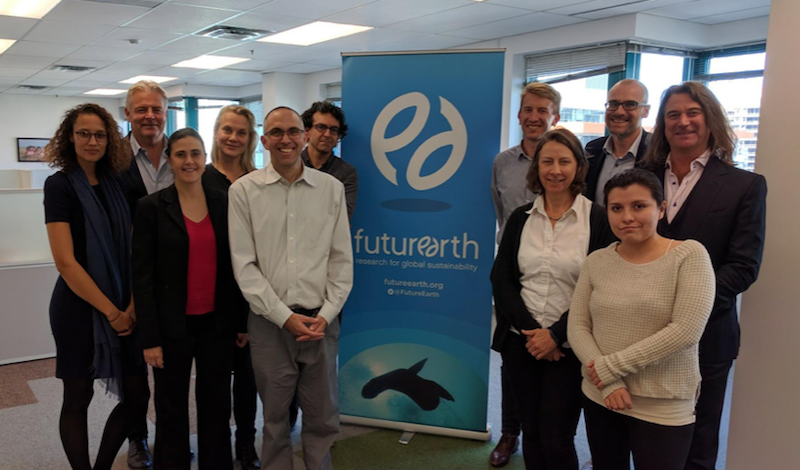Urban Knowledge-Action Network launches new project on biodiversity and sustainable cities
Future Earth in cooperation with the Convention on Biological Diversity, Stockholm Resilience Centre, SwedBio, The Nature Conservancy (TNC), International Council for Local Environmental Initiatives (ICLEI) and other partners launched the first phase of an ambitious project called “Integrating Nature for Urban Sustainability” in Montreal, Canada, on 26 October. This project aims to make the consideration of biodiversity and natural ecosystems in urban design and planning more mainstream, ensuring that cities around the world can meet global targets for sustainability and human well-being.

Attendees at a recent workshop on cities and biodiversity pose for a photo. Credit: Future Earth
An interdisciplinary group of 16 participants, including urban planners, biodiversity scientists and representatives from international policy-making organisations, gathered for the event. They sought to develop a holistic guideline for governments to integrate natural ecosystems into urban design and planning. These discussions will be captured in an action-oriented report that brings together data to establish the magnitude of the challenges cities face, identify risks and establish criteria for solutions in urban areas.
Natural ecosystems play an integral role in human well-being and contribute greatly to the sustainability of cities. Yet sustainable urban design and planning efforts often fail to consider biodiversity. At the same time, urban areas continue to grow at unprecedented rates. By 2050, 70% of the world’s population will live in urban areas and will rely on biodiversity and healthy ecosystems for many basic services. This rapid urban expansion poses risks to the exceptional and unique biodiversity in many cities that is critical for sustainability. Forecasts suggest that more than two-thirds of all species impacted by urban expansion will be in countries with low levels of political stability or regulatory quality. Scientists are still uncertain about how the loss of biodiversity will affect society in those regions.
To tackle these issues, the project team will identify at-risk urban areas based on three focal spatial points. They include the direct impact of urbanisation on peri-urban environments, the direct impact of urbanisation on protected areas and the indirect impact of urbanisation through teleconnections.
The project is premised on two underlying hypotheses: The expansion of urban areas decreases natural habitat; increasingly infringes upon protected areas; and produces broader sustainability issues through the erosion of connectivity in the regions.
Prioritising biodiversity and natural ecosystems within the concept of sustainable cities will help to ensure that globally significant biodiversity is protected, essential ecosystem services can continue to support the adaptation of human communities to climate change and that capacity is built around urban design and planning in cities to ensure human well-being.
“This is a very exciting project,” said Anne Hélène Prieur-Richard, Montreal Global Hub Director at Future Earth. “It aims not only to increase our knowledge but has been co-designed since its inception through a strong engagement between the scientific sustainability community, national and local policy communities and practitioners working in low-income countries and least-developed countries in the fields of biodiversity conservation and cities.”
Robert McDonald, Lead Scientist for the Global Cities programme at The Nature Conservancy, echoed Prieur-Richard’s sentiments: “It is exciting having scientists working on research to influence global policy to help conserve biodiversity in some of the fastest growing urban regions.”
While other projects haved detailed the importance of understanding the links between growth in cities and natural ecosystems, “Integrating Nature for Urban Sustainability” is the first project of its kind.
“We are trying to integrate biodiversity with urban growth, and that is revolutionary,” said Richard Weller, Professor and Chair of Landscape Architecture at the University of Pennsylvania in Philadelphia, USA, at the concluding session of the workshop.
DATE
November 7, 2017AUTHOR
Future Earth Staff MemberSHARE WITH YOUR NETWORK
RELATED POSTS
Program Now Available for the Year’s Top Sustainability Science and Innovation Event in Finland
Future Earth Members Join UN Ocean Conference in Barcelona
Apply for the 2024 Pathways Autumn School: Transformative Research for a Just World and a Habitable Planet